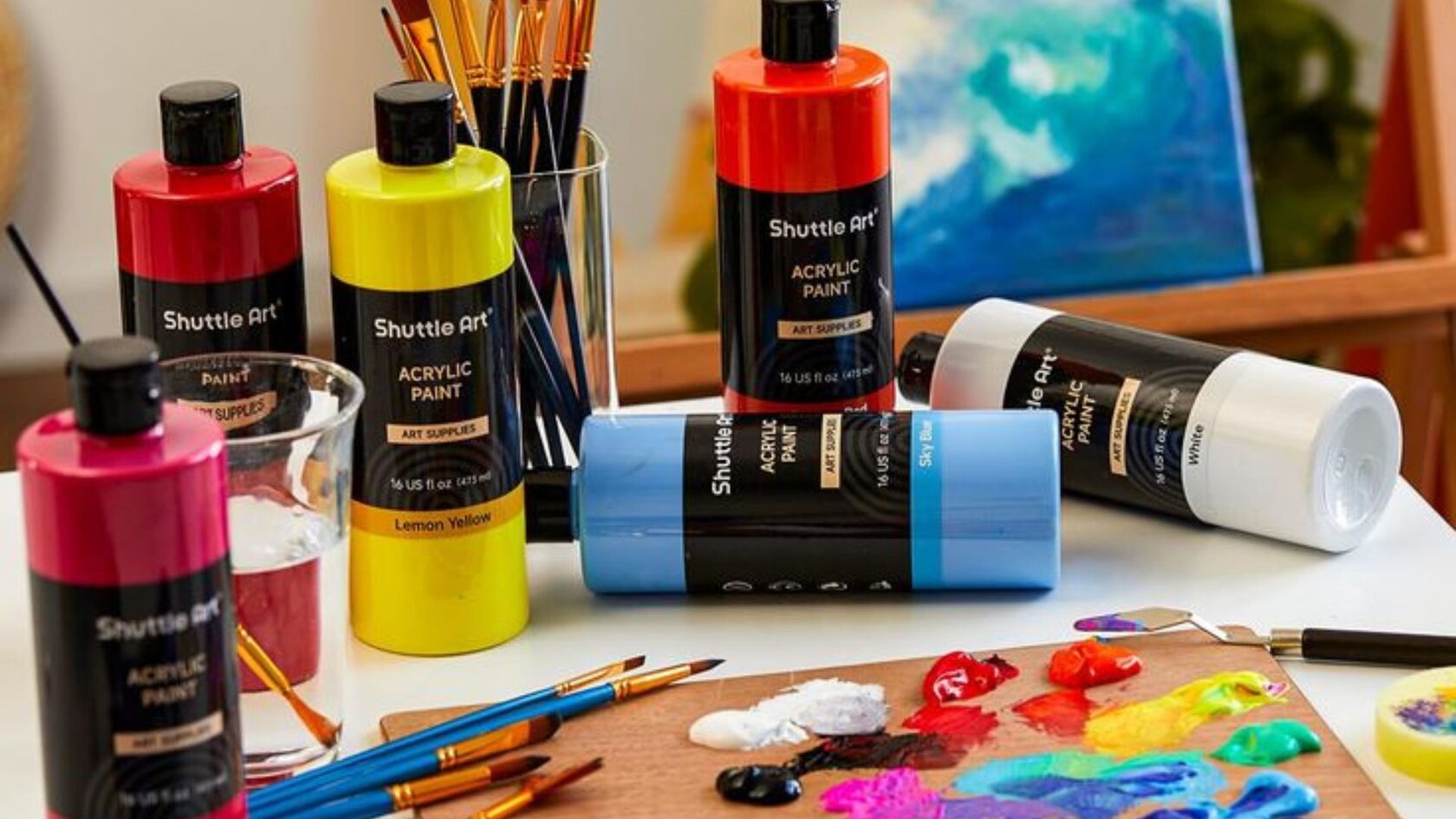Acrylic paint has emerged as a dynamic medium in the realm of art, offering a plethora of advantages and some drawbacks for artists of all levels. From its vibrant hues to its rapid drying time, acrylic paint has revolutionized the way artists approach their craft. However, like any artistic material, it comes with its own set of pros and cons that artists must consider. In this article, we delve into the advantages and disadvantages of using acrylic paint, providing insights to help artists navigate their creative journey with this versatile medium.
What is Acrylic Paint?
Acrylic paint emerged in the 1950s initially as house paint but gained prominence in the art world during the 1960s. Its versatility, vibrancy, and stability have since made it a favorite among contemporary artists.
Compared to traditional mediums like oil and watercolors, acrylic paint is relatively new but has quickly become a staple in the art world. Its water-soluble nature and rapid drying time, followed by water-resistance upon drying, make it a preferred choice for many artists.
Acrylic paint stands out due to its adaptability. By adjusting water dilution or incorporating acrylic gels, mediums, or pastes, artists can achieve effects reminiscent of watercolors, gouache, or oil paintings. Moreover, acrylic paint offers unique characteristics not found in other mediums.
Unlike historical practices where artists would mix their paints, acrylic paint is typically purchased ready-to-use due to its fast-drying nature and complex formulation. The availability of a wide range of acrylic mediums further enhances its versatility, allowing artists to customize their painting techniques and surfaces.
While traditional acrylic paints dry rapidly upon application, modern variants offer extended drying times and can even be reactivated after drying. Brands like Liquitex, Winsor & Newton, Golden, and Grumbacher produce traditional acrylics, while modern alternatives come from brands like Golden and Chroma.
Compared to traditional mediums like oil and watercolors, acrylic paint is relatively new but has quickly become a staple in the art world. Its water-soluble nature and rapid drying time, followed by water-resistance upon drying, make it a preferred choice for many artists.
Acrylic paint stands out due to its adaptability. By adjusting water dilution or incorporating acrylic gels, mediums, or pastes, artists can achieve effects reminiscent of watercolors, gouache, or oil paintings. Moreover, acrylic paint offers unique characteristics not found in other mediums.
Unlike historical practices where artists would mix their paints, acrylic paint is typically purchased ready-to-use due to its fast-drying nature and complex formulation. The availability of a wide range of acrylic mediums further enhances its versatility, allowing artists to customize their painting techniques and surfaces.
While traditional acrylic paints dry rapidly upon application, modern variants offer extended drying times and can even be reactivated after drying. Brands like Liquitex, Winsor & Newton, Golden, and Grumbacher produce traditional acrylics, while modern alternatives come from brands like Golden and Chroma.

Advantages and Disadvantages of Using Acrylic Paint
TOXICITY LEVELS
Contemporary acrylic paints, being water-based, eliminate the need for toxic solvents. While they still contain mild toxins, they do not require retarders to slow drying time.
DRYING TIME
Advantages: Modern acrylic paints boast extended drying times, allowing them to remain workable on a sealed palette for several days. This feature enables the use of wet-in-wet techniques akin to oil paints, without the need for a retarder.
Disadvantages: Waiting periods between drying times are necessary. If you prefer rapid drying, contemporary acrylic paint may not be suitable.
REACTIVATION
Advantages: Contemporary acrylic paint can be reactivated with water, even after drying. This allows for adjustments and lifting off of paint.
Disadvantages: Over time, reactivation capabilities diminish, and painting over dry acrylics may result in some color bleed.
DURABILITY
Advantages: Modern acrylic paint exhibits greater flexibility and durability compared to oil paints.
Disadvantages: Despite ongoing efforts to assess their longevity, the durability of modern acrylic paint is still being evaluated due to its relatively recent emergence in the art world.
Contemporary acrylic paints, being water-based, eliminate the need for toxic solvents. While they still contain mild toxins, they do not require retarders to slow drying time.
DRYING TIME
Advantages: Modern acrylic paints boast extended drying times, allowing them to remain workable on a sealed palette for several days. This feature enables the use of wet-in-wet techniques akin to oil paints, without the need for a retarder.
Disadvantages: Waiting periods between drying times are necessary. If you prefer rapid drying, contemporary acrylic paint may not be suitable.
REACTIVATION
Advantages: Contemporary acrylic paint can be reactivated with water, even after drying. This allows for adjustments and lifting off of paint.
Disadvantages: Over time, reactivation capabilities diminish, and painting over dry acrylics may result in some color bleed.
DURABILITY
Advantages: Modern acrylic paint exhibits greater flexibility and durability compared to oil paints.
Disadvantages: Despite ongoing efforts to assess their longevity, the durability of modern acrylic paint is still being evaluated due to its relatively recent emergence in the art world.

Ready to explore the pros and cons of acrylic paints for yourself? Dive into the online course 'Acrylic Painting' offered at Fantasy Room Online School. With detailed step-by-step tutorials, our professional tutors will expertly guide you through the captivating journey of creating stunning abstract artworks, capturing the essence of still life compositions, and painting breathtaking landscapes that transport you to serene vistas. Join us and unleash your creativity with acrylics!
Advantages and Disadvantages of Acrylic Paints when Compared with Other Paint Mediums
Advantages
- Versatility: Acrylic paint can be applied to a wide range of surfaces, including canvas, wood, paper, glass, fabric, and more, with proper preparation.
- Quick Drying: Acrylic paint dries rapidly, allowing for faster project completion.
- Water-Soluble: Easily washable from hands and brushes with soap and water while still wet, eliminating the need for paint thinners.
- Low Toxicity: Acrylic paint is less toxic and safer around children and pets compared to some other mediums.
- Affordability: Acrylic paints are more budget-friendly compared to many other types of paint.
- Flexibility: Acrylics can be mixed with various mediums to achieve different textures, adhesion properties, or adjust drying time
- Durability: Acrylic paint is flexible and resistant to cracking, peeling, or yellowing over time.
- Vibrancy: Acrylic paints offer vibrant and vivid colors.
- Water-Resistance: When dry, acrylic paint is water-resistant.

Disadvantages
- Color Shift: Acrylic paint may darken as it dries, resulting in a different color than initially applied.
- Fast-Drying: Requires quick work due to its rapid drying time.
- Difficult Cleanup: Dried acrylic paint is challenging to remove from brushes, nails, or clothing.
- Perceived Value: Some art galleries and collectors may not consider acrylic paintings as valuable as those created with other mediums.

In conclusion, while acrylic paint offers numerous advantages such as versatility, quick drying time, water solubility, and affordability, it also comes with its share of disadvantages, including color shift when dry, fast drying time requiring quick work, and difficulty in removing dried paint from brushes and clothing. However, despite these drawbacks, the benefits of acrylic paint, such as its flexibility, durability, and vibrant colors, make it a popular choice among artists worldwide. Ultimately, the decision to use acrylic paint depends on individual preferences, artistic needs, and the specific requirements of each project. Whether you're a seasoned artist or just starting your creative journey, understanding the pros and cons of acrylic paint empowers you to make informed choices and achieve your artistic vision with confidence.











